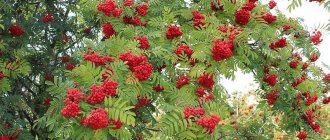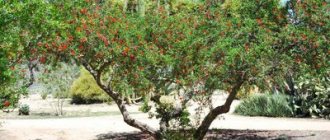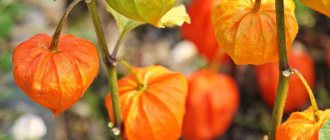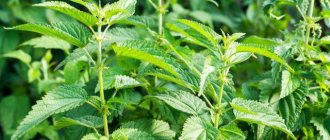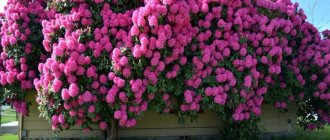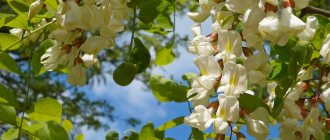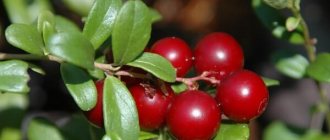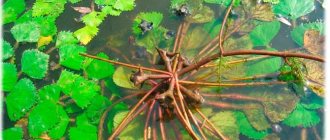Each type of cedar tree looks very decorative in any season of the year, thanks to its unusual crown.
Cedar contains a huge number of healing properties, and that is why this tree is considered precious.
In the middle zone, as a rule, you can find Korean, European, Siberian, and dwarf cedar. Photos of cedar trees and their descriptions can be found on this page.
Photos and description of cedar
Cedar is considered a valuable plant due to its magnificent wood and healing needles. This type of tree is very well suited for landscaping any areas.
Most people probably know what a cedar tree looks like: in a word – a giant. The genus of this tree can reach a height of 45 meters.If pine has hard needles, the whorl contains a maximum of 3 needles, then cedar has the opposite: soft, long, organized in bunches of 4-5 pieces.
There are two types of shoots - elongated vegetative and shortened generative. Male buds look like ears of corn and are usually red or yellowish. Female buds are small purple bumps.
The root of the tree can be described in one word - powerful.
Cedar trees purify the air in a remarkable way, which is why it is so pleasant to be near them. Cedar cannot grow in sand; the most favorable soils for it are sandy and loamy.
In the forest, a cedar tree begins to bear fruit at 30-60 years, in gardens at 15-20, thanks to good care and fertilizers. The trees pollinate well, so it is best to plant 2-3 trees nearby. The seed develops within 1.5 years.Habitat
The places where cedar grows everywhere are the southern and eastern regions of the Mediterranean coast. The trees prefer mountainous areas with cool summers and mild winters. They are also found in the foothills of the Himalayas, in North-West Africa, in Lebanon, where cedar is one of the national symbols and is depicted on the state flag and coat of arms.
In Russia, cedar grows only on the southern coast of Crimea, where it has successfully acclimatized and produces abundant self-seeding. In other regions it is found only in botanical gardens and nurseries. And that tree, which is called Siberian cedar, is actually a representative of the genus Pine and is correctly called Siberian, European or Korean pine. These varieties share the same family with cedars. But everyone’s favorite and extremely healthy “pine nuts” are produced by Siberian pine.
How to grow and care for a cedar tree
Cedar gives the garden a look of solidity and power, firmness and cheerfulness. The tree does not need constant care.
It is necessary to plant seedlings in a well-lit area at a distance of 4-5 m. The crown should be developed on a low stem. It should be branched and have many peaks.
Germination of nuts lasts 2 years. They need to be planted in the fall, then they will begin to sprout in March-April. However, there is another way of planting: stratify the nuts in moisture, soak them for a day, and plant them in the spring.It is necessary to break out the buds that grow on the sides in March-April, before the growing season begins. The area for cedar should be large and have suitable soil.
If you plant using the second method, whorls will appear in 4-5 years, the tree will need shade. Cedar can also grow in sphagnum bogs. The tree is practically independent of the surrounding temperature - it tolerates both frost and drought.
Growing from seeds
You can take a longer route: grow cedar from a seed - a nut.
In the fall, collect ripe cones and select the best quality vigorous nuts. Select the best quality vigorous nuts. Then follow the following order:
- Place the seeds in a cup of water and keep them like this for 3 days, changing the water daily. During this time, high-quality seeds will swell and sink to the bottom, and empty ones will remain on the surface of the water;
- benign seeds are kept for 2-3 hours in a strong solution of potassium permanganate;
- then the nuts are placed in a moist substrate (sphagnum, peat, sawdust) and stratified for at least 3 months;
- before sowing, the seeds are re-soaked in a strong solution of potassium permanganate for 24 hours, then dried;
- sown in protected soil (greenhouse, film cover) in well-prepared soil: a mixture of superphosphate, wood ash and peat is added per 1 m of the seed furrow in a ratio of 1:2:20. The seeding depth is 2.5-3 cm. The crops are mulched (0.5-1 cm layer) with peat and sawdust;
- Before germination, crops are regularly watered; in order to prevent fungal diseases, you can alternate ordinary water for irrigation with a solution of potassium permanganate.
Cedar shoots.
Photo from ecology.md In protected soil, Siberian pine seedlings grow up to 2 years of age. Then the cover is removed. At the age of 6-8 years, the seedlings are ready for planting in a permanent place.
Photo of cedar tree
Care
The top layer of soil in the tree trunk circle should not dry out, so mulching is necessary. During dry periods - regular watering. Digging up the soil in the tree trunk circle is unacceptable; only superficial loosening is possible, but if there is mulch, there is no need for it. Periodic irrigation of the crown is very beneficial for cedar, especially in the absence of rain. Top dressing (20 grams of potassium sulfate per 10 liters of water) is applied three times per season (May, June, July) under each tree.
Beneficial properties of needles and its use in folk medicine
- The benefits of various parts of the cedar tree in the fight against a variety of ailments have been confirmed not only by folk, but also by traditional medicine, because essential oils and pine extracts are often included in preparations to eliminate problems of the following organs and systems of the human body:
- respiratory system;
- digestive systems;
- kidneys and liver;
- genitourinary system;
- organs of the cardiovascular system.
When properly prepared, medicinal infusions and decoctions will be effective in the treatment of anemia, hypertension, tuberculosis, atherosclerosis, mastitis, arthritis, gastritis and stomach ulcers . The effectiveness of cedar medicines in the prevention of cardiovascular pathologies is also scientifically confirmed today, and the resin of the plant is a good antiseptic that inhibits the growth of bacteria that cause diphtheria and staphylococcus.
If necessary, infusions with the addition of oleoresin can also be used as an external remedy in the treatment of furunculosis, purulent wounds and abscesses. Of course, essential oils, infusions and decoctions will have different levels of beneficial properties, so before preparing this or that medicine, you should decide on its most preferred form:
- Tincture of pine needles and cedar sprouts is an excellent diuretic, as well as a good remedy for the treatment of bronchial asthma, tuberculosis, inflammatory processes in the respiratory system, prostatitis and uterine bleeding, not to mention arthritis, rheumatoid pain and gout (alcohol tincture perfectly warms up the body) . In addition, this tincture can be added to water when taking a bath, which will help relieve fatigue, increase the body's immune strength and improve emotional well-being.
- Essential oil from the seeds of the plant is a nutritious product that helps remove phlegm from an unproductive cough and eliminate the unpleasant symptoms of stomach ulcers and other gastrointestinal diseases. It is used externally in the preparation of compresses and solutions for lotions during the treatment of burn wounds.
- Decoctions of pine needles are often used for bronchitis, pneumonia, sore throat, stomatitis and even a runny nose, instilled into the nostrils.
- Camphor from cedar resin can be used to eliminate ailments of the nervous system and even schizophrenia, and baths with turpentine will be appropriate in case of large amounts of salt deposits in the joints.
Did you know? In ancient times, cedar wood was considered one of the best building materials. It was from it that the sarcophagi of the pharaohs were often made, and temples and palaces were erected.
Medicinal properties
Considering the above ailments, which are helped to cope with various infusions and decoctions based on different parts of the cedar tree, it is not difficult to guess about the specific medicinal capabilities of the plant.
- The list of which includes the following effects on the human body:
- anti-inflammatory;
- diuretic;
- expectorant;
- antibacterial;
- antiscorbutic;
- antimicrobial;
- hemostatic;
- sedative;
- immunomodulatory;
- anti-asthmatic;
- blood purifying;
- restorative.
In addition, with regular use of various products prepared using cedar raw materials, there is every chance of improving blood composition, increasing the elasticity of vascular walls, lowering cholesterol levels in the body, lowering blood pressure and reducing excess body weight, while simultaneously promoting increased production of juice in the stomach and reducing its acidity . Not only pine needles, but also cedar wood can release substances that help purify indoor air . This means that even wooden products from the described plant can bring benefits to humans, and not only aesthetic ones.
Contraindications
There are no significant contraindications to the use of cedar in folk medicine. The undesirable consequences of such treatment are explained mainly by individual intolerance to the chemical components of the plant and the body’s tendency to allergic reactions to pine needles . At the same time, you should not uncontrollably take prepared infusions and decoctions in large quantities.
Healing capabilities of oil
Oil is made from nuts. This thick amber-colored liquid with a nutty aroma is a full-fledged analogue of olive oil. For minimal contact with air, it is better to keep it in a glass container with a narrow neck in a cool and dark place.
Natural antioxidants that are in its composition save the product from rancidity, but still, to extend the shelf life, the rules must be followed.
The sediment that eventually appears at the bottom is not dangerous to humans: it contains useful phospholipids and microelements.
Cedar oil helps control cholesterol levels and promotes weight loss. The presence of terpenes in the product provides such capabilities.
The oil contains many substances: vitamins A, B1, B2, B3 (PP), B6, D, E, F
Use in landscape design
Cedars are, of course, tall trees, and not every site has room for them. But domestic breeders have developed varieties that do not reach very large sizes, retain all the beneficial properties and can even please you with delicious nuts.
And low-growing dwarf cedar and other dwarf varieties will decorate any rocky garden.
Since cedars grow very slowly, it would be good to plant low-growing bushes or trees between the young seedlings. And by sowing lupine between them, you will get a beautiful composition and additional biological fertilizer.
We figured out how to plant cedar in a garden plot. This is a troublesome task at first, but the main thing is that the young trees take root. And then more than one generation in your family will be able to enjoy the delicate aroma of cedar resin carried around by the wind, feast on healthy and tasty pine nuts and admire the lush crowns of these majestic beauties.
Our advice has been tested in practice
On spacious and bright garden areas (from 800 to 2,000 sq.m.), OBI specialists recreated the atmosphere of a real coniferous forest: the tart aroma of pine needles is felt in the air, small plants form a fluffy green cover, and the beauty of powerful “large-sized” trees - pine, thuja, fir - attracts attention and makes you think about buying an already mature tree, which will decorate the garden landscape immediately after planting. In addition to cedars, OBI's assortment includes both popular and rare varieties of coniferous plants from European manufacturers: thuja, pine, fir, juniper, spruce.
